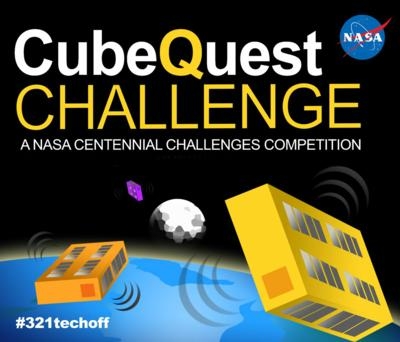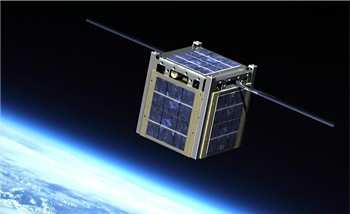Winner Could Send CubeSat To The Moon On Orion Spacecraft
Registration now is open for NASA's Cube Quest Challenge, the agency’s first in-space competition that offers the agency’s largest-ever prize purse.

Competitors have a shot at a share of $5 million in prize money and an opportunity to participate in space exploration and technology development, to include a chance at flying their very own CubeSat to the moon and beyond as secondary payload on the first integrated flight of NASA's Orion spacecraft and Space Launch System (SLS) rocket.
"NASA's Cube Quest Challenge will engage teams in the development of the new technologies that will advance the state of the art of CubeSats and demonstrate their capabilities as viable deep space explorers," said Michael Gazarik, associate administrator for NASA's Space Technology Mission Directorate at NASA Headquarters in Washington. "Prize competitions like this engage the general public and directly contribute to NASA's goals while serving as a tool for open innovation."
Challenge objectives include designing, building and delivering flight-qualified, small satellites capable of advanced operations near and beyond the moon. The challenge and prize purse are divided into three major areas:
- Ground Tournaments: $500,000 in the four qualifying ground tournaments to determine who will have the ability to fly on the first SLS flight;
- Lunar Derby: $1.5 million for demonstrating communication and CubeSat durability at a distance greater than almost 2.5 million miles (4,000,000 km), 10 times the distance from the Earth to the moon; and
- Deep Space Derby: $3 million for demonstrating the ability to place a CubeSat in a stable lunar orbit and demonstrate communication and durability near the moon.

The Cube Quest Challenge seeks to develop and test subsystems necessary to perform deep space exploration using small spacecraft. Advancements in small spacecraft capabilities will provide benefits to future missions and also may enable entirely new mission scenarios, including future investigations of near-Earth asteroids.
"Cube Quest is an important competition for the agency as well as the commercial space sector," said Eric Eberly, deputy program manager for Centennial Challenges at NASA's Marshall Space Flight Center in Huntsville, Alabama. "If we can produce capabilities usually associated with larger spacecraft in the much smaller platform of CubeSats, a dramatic improvement in the affordability of space missions will result, greatly increasing science and research possibilities."
All teams may compete in any one of the four ground tournaments. Teams that rate high on mission safety and probability of success will receive incremental awards. The ground tournaments will be held every four to six months and participation is required to earn a secondary payload spot on SLS.
The Lunar Derby focuses primarily on propulsion for small spacecraft and near-Earth communications, while the Deep Space Derby focuses on finding innovative solutions to deep space communications using small spacecraft. Together, these competitions will contribute to opening deep space exploration to non-government spacecraft.
NASA's Centennial Challenges drive progress in aerospace technology -- of significant value to the agency's missions -- and encourage broad-based participation in aerospace research and development. The challenges help find the most innovative solutions to technical challenges through competition and cooperation. There have been 24 Centennial Challenges events since 2005. NASA has awarded more than $6 million to 16 challenge-winning teams.
NASA's Centennial Challenges Program is part of the agency's Space Technology Mission Directorate, which is responsible for innovating, developing, testing and flying hardware for use on future NASA missions. During the next 18 months, the directorate will make significant new investments to address several high-priority challenges for achieving safe and affordable deep space exploration.
As an interesting aside to this story, it seems the agency announced the competition before they were quite ready to announce the competition. NASAWatch.com reports that informaiton about the contest was published in the Federal Register Monday, but that the link to the contest website was not active. When asked, NASA said that the site would not be live until December 2.
Keith Cowing of NASAWatch.com said that NASA told him that the Federal Register has a "limited audience" and that the agency "decided that the Challenge would get more attention during the events leading up to the Orion Launch. The Federal Register has a limited audience, whereas millions will be watching the first Orion launch. This is the largest NASA Prize Purse and first competition in space. CCP seeks innovations from diverse and non-traditional sources of citizen inventors, private businesses, and academia. NASA HQ wanted to promote this opportunity to the largest audience possible, not just to those within the aerospace industry."
The site is now live.
 ANN's Daily Aero-Linx (05.02.24)
ANN's Daily Aero-Linx (05.02.24) ANN's Daily Aero-Term (05.02.24): Touchdown Zone Lighting
ANN's Daily Aero-Term (05.02.24): Touchdown Zone Lighting Aero-News: Quote of the Day (05.02.24)
Aero-News: Quote of the Day (05.02.24) ANN FAQ: Contributing To Aero-TV
ANN FAQ: Contributing To Aero-TV NTSB Final Report: Cirrus Design Corp SR20
NTSB Final Report: Cirrus Design Corp SR20




